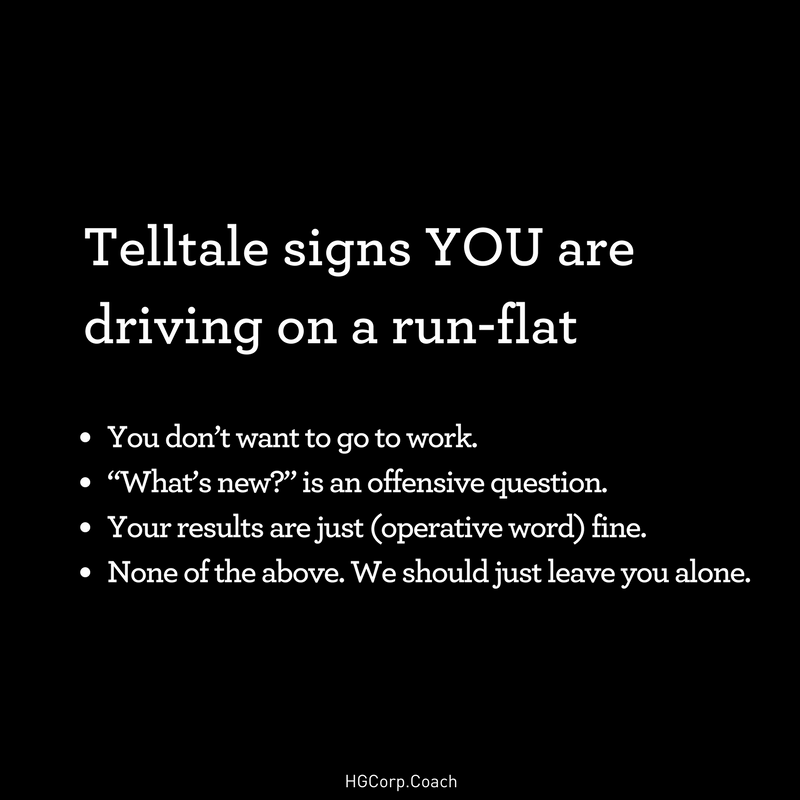Barring physical ailments, getting fired, being left, getting cheated on, raising teens, quitting carbs, (and whatever else is on your what’s worse-list), a flat tire at least earns a spot on the “can ruin a day” list, right?
For the action-oriented, results-driven species we are, a flat tire means something dreadful. We not only have to stop what we’re doing, we have to wait, leak time, and deal. (Besides the potential pile-up of cars behind you, just think of the emails in your inbox …)
‘No thanks,’ we say. We need to keep going. Need to keep working. So we do.
Thanks to technology, we don’t stop when we get home (thanks, iPhone!). We don’t stop when we’re on the plane (thanks, mile-high wireless!). And we don’t even stop when we get a flat tire (thanks, run-flat!).
What’s a run-flat?
Run-flat:
Noun
- A pneumatic vehicle tire that is designed to resist the effects of deflation when punctured, and to enable the vehicle to continue to be driven at reduced speeds and for limited distances.
Adjective
- The way many of us approach our work (and life). We often operate at a reduced speed, pretending things are fine, when they’re not. Whether we’re happy, proud, resolved, and/or there’s a rattling sound under our hood (aka head), we can still get our jobs done. There’s no real need to stop, pull over, and deal. After all, most of us still can function at work and in our lives at a 7 out of 10. Sure, we’re not amazing, but we’re not awful either. We drive right over the fact that if we just stopped and dealt with the “puncture,” we’d enable another level of happiness, pride, and even results at work.
In automobile terms, a run-flat tire allows you to keep driving about 100 miles even after all the air has gone. Gone are the days where you have to get out of the car in the cold or the rain, or step onto a busy highway, or get out of the car in a sketchy part of town. Sure, you may have to reduce your speed, but you can still keep going.
But when you lock yourself into a run-flat approach at work and/or your life, what’s the long-term cost?
My Personal Puncture
As an executive in my company, I’m responsible for generating revenue, improving our operations, finding solutions, coaching clients, AND leading workshops.
That’s my job description.
Although I had a lot of experience leading in classrooms as a teacher before joining HG Corp, this aspect of my job—the part in which I’m responsible for public speaking—marked my learning curve.
Fortunately for me, as part of a business consulting and corporate coaching company, I am regularly coached, supported, and trained, and I am lucky to have a powerful mentor and trainer. In one of our conversations, she and I were discussing my strengths and weaknesses, and she used the following words that stuck in my head: “You just don’t lead with any ooomph.”
(At least that’s what I heard her say.)
Now, for those of you that know me at all, those six words (plus one sound) may come as a surprise. After all, I am a preacher’s son. I not only like speaking, story telling, and teaching, I love it. Subsequently, my mentor/higher up’s words not only stung, they stuck. Yes, like a rusty nail at a construction site over which I drove and drove and, (did I mention?) drove.
But, like all good mentors, mine was ever determined to develop/train/grow me.
And off we went to lead a series of workshops together. And off I most certainly was. I tried to lead with more gusto. I experimented with being more aggressive. I told better stories. Hell, I even told my mentor’s stories.
But to no avail.
I just couldn’t shake the self-doubt. I watched myself not be a passionate charismatic leader. I listened to myself not pack a punch. What did I successfully do, you wonder? I successfully worried. Worried about what my mentor thought about me and what I was saying and how I was saying it. (As empowering and oomph-provoking as it sounds …)
Needless to say, I drove well over a 100 miles on that flat.
Telltale signs YOU too are driving on a run-flat
Here are some telltale signs that you’re running flat:
- You don’t want to go to work. [Worse than before.]
- A conversation you had with your boss, co-worker, direct report, friend, partner, etc. did not go as you intended. So much so, you’ve had the conversation with them many more times … in your head.
- You keep putting something off and dismissing, excusing, and/or justifying it.
- Your results are just (operative word) fine. They’re neither offensive nor terribly impressive.
- You check to see if the second coffee you just had (a Grande Quad!) was indeed caffeinated. You’re pretty sure it was not. You add the Barista to your loathe list.
- Your favorite psychic (the voice in your head) knows what another person really meant by what they said, didn’t say, did, didn’t do, etc. and it keeps playing on a loop. Sometimes you even play it for others. Sure, to see what they hear and think, but mostly to confirm what you know you heard.
The truth is, something did happen that gave you that flat. Whether it’s a thought you dismissed or an action you need to take: the dashboard warning light is on.
However much you wish it weren’t.
Schedule a Consultation
Get a feel for how The Handel Method® could benefit your organization.
How to change a run-flat (yours and mine)?
The first step is pulling over to deal. And by deal, I mean you first truly must have a vision for who or how you want to be, whether it’s as an executive, leader, CFO, partner, parent, mentor, etc. You are either going to live true to your highest ideal for yourself (an 8, 9, or 10 out of 10) or run-flat at about a 7, like I was in the area of leading workshops.
My oomph-lessness could be your “I’m not good at managing people” or “I suck at sales,” or “I’m not a morning person.” These are theories that we sell ourselves, buy into, and use so as to not have to step up and get into the right actions that match our highest visions.
In my view, it’s much easier to get from a 3 or 4 to a 5 or 6 in our life. But getting from a 7 (a run-flat) to an 8, 9 or 10 is not the same kind of “easy” incremental step up. To leap over the threshold of mediocre into acceptable, proud, happy and effective, there’s a threshold of hell you have to leap through, a real conversation to be had, and a decision and commitment. Because, a 7 is decent and good. It’s just not our dream when we all know we’re capable of extraordinary, wondrous things.
Speaking of. Yes, I finally pulled over and addressed MY own run-flat.
I went to talk to my mentor to confess that although on the surface I had been following the oomph-upping advice she offered in our original conversation, in reality I was not dealing with the bigger picture puncture: that I was letting people-pleasing run the show.
I clearly saw that I had been trying to lead workshops a certain way (aka hers) in order to satisfy my ego and impress her. And that this type of approach would NEVER pack the required punch for my clients.
You know why?
Because it was all about me. And until I was willing to see my own flat for what it was, I was going to keep getting hurt, annoyed, and flustered by my mentor’s notes, her (rightful) need to backseat drive me while I was leading, and not see the real breakdown.
I needed interior work on my car, or, better yet, my care.
So, with that flashing light, I took control of the wheel and put my attention where it belonged—on my clients. In practically no time, I stopped idling and, gasp, I even told my mentor to raise her hand if she had something to add while I led the workshop.
Yes, I honked. Only this time I honked at the right obstacle—my focus.
You know what my mentor did? Slam on the brakes? Nope. She laughed, relieved I finally heard the clunk. Sure, I needed oomph, not to prove I was worthy of leading, but to move the needle for the progress of the clients. My interior light went back on. The dashboard warning light went off. And, yes, I got my oomph (all wheel drive?) back.
If you’re moving slower than you’d like, time to check under your own hood (head) and get honking.
Love,
Will

